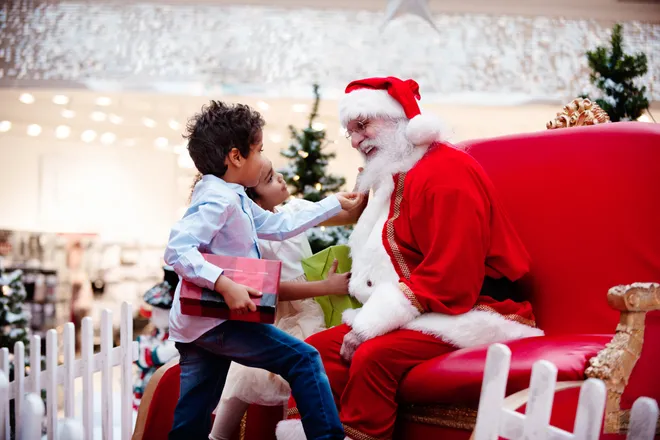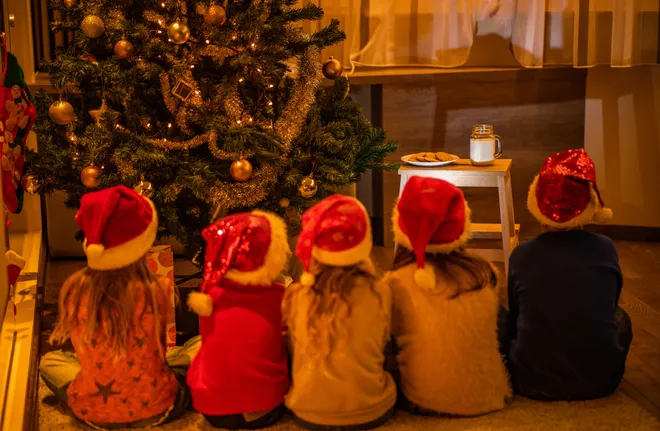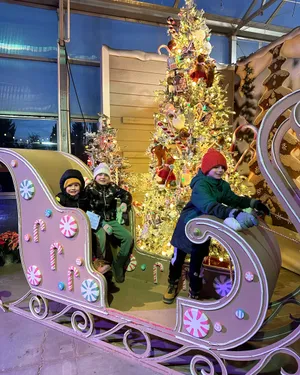How should you talk to kids about Santa? Therapist shares what is and isn’t healthy.

Santa Claus is a big part of the Christmas tradition. From music to retail to the shows our children watch, the jolly old man is front and center. Parents who celebrate the holiday may have to decide early on how they wish to introduce the story of Kris Kringle. Should it be a simple tale of a man who once lived? Or a much more involved narrative with a whole lot of magic behind it? The answer may be both.
The topic of Santa doesn't have to be as hard as it feels. It can be child-lead, Jessica VanderWier, mother, psychotherapist and founder of Nurtured First, tells USA TODAY. There is no "right way" to talk about Santa Claus, there's just … your way.
A good place to start is remembering what Christmas magic was for you, VanderWier says. In her work as a therapist, she asks parents to tune into the values and experiences they had growing up to create their Christmas tradition involving Santa Claus. Usually, in doing so, guidance for what to teach – and what not to teach – surfaces.
"Some (parents) had incredible experiences imagining Santa and believing that Santa was real and that was super magical for them. Other parents have had really traumatic experiences where Santa was used to manipulate their behavior," VanderWier says.
An introduction to Santa

Kids become "Santa aware" usually between ages 3 and 4, so this is around the age parents can begin the Santa conversation.
"I didn't tell my kids Santa is real," says VanderWier, a mom to three daughters ages 6, 3 and 18 months. "I say that Santa was a person and now he's someone we can imagine coming and bringing presents into our house."
VanderWier asks her kids what they would like to imagine about Santa Claus instead. Each kid could choose something different.
Keep it about closeness
If a household chooses to imagine that Santa is real, VanderWier suggests focusing on "closeness and togetherness."
"Use Santa as a way to foster relationship with your kids. That magical feeling we remember all had to do with feeling connected, feeling that sense of togetherness with family," VanderWier says.
When her clients share their good memories of Santa Claus, a theme emerges: closeness with family. Whether it's making milk and cookies to set out for Santa, or sitting and listening for stomps on the rooftop, it's creating that Christmas magic together that children cherish most.
'Good enough, not perfect':How to manage the emotional labor of being 'Mama Claus'
What not to do
It's really up to each individual family to decide how they want their Christmas tradition to form, but there are some universal "don'ts" we all should follow surrounding Santa, VanderWier says.
- Don't use Santa as a way to manipulate a child's behavior. Avoid naughty and nice language like, "Santa is not going to come if you don't behave." The story of Santa should encourage connection, not fear.
- Don't force a child to sit on Santa's lap, because this goes against the messages we try to teach kids about consent.
- Don't make fun of children who are nervous or scared of Santa Claus.
- Try not to make the biggest gifts come from Santa. Not all families can afford elaborate gifts, so choose wisely on what to label from Santa, because kids will compare.
- Encourage your kids not to ruin anyone else's Santa story by forcing their belief or unbelief on them. The spirit of Santa remains whether kids believe he is alive or imaginative.
Reindeer in Here:This dad wanted a stress-free Christmas tradition for his kids. So he invented one.

The spirit of Santa has no age cap
From the beginning, but especially as kids grow older and more aware of the unlikelihood of a man delivering presents to the whole world in one night, Santa has to be about kindness and love, VanderWier shares. Our talk of Santa should always reflect that.
“We believe Santa is a spirit of happiness and kindness. Santa isn’t one person anymore, but a kind, loving feeling that comes from being together and doing kind things for each other," VanderWier writes in her guide on how to talk to kids about Santa.
How one mom handled the 'Santa talk'
Meg Raby, mom, children’s author and full-time employee at the nation’s leading nonprofit in sensory inclusion, Kulturecity, has two children right around that "age-out" age of 8. Yet, "they have the imagination for a generous and kind-hearted man going around the world at night," Raby tells USA TODAY.
When Raby's kids were 8 and 6-years-old, they didn’t believe in Santa, because friends at school let them in on the fact that "there was no logical way Santa could go to every single house and squeeze down a chimney," Raby says.
"I neither confirmed their newly stated beliefs nor condemned them" Raby says. So, it seemed that Santa had left the scene. "Or had he?"
Raby's kids, now 9 and 7, have decided they believe in Santa again. "I again neither confirmed nor condemned the notion, but I found it quite remarkable and also a bit inspiring," Raby says.

"It hit me," Raby shares. "We can’t lose our dispositions toward the imaginative. We tend to, us adults. We tend to let only logic reign in our bones, and we miss out on what could be. On the magic of the season and beyond."
So it seems the way a child transitions out of their belief in Santa is the same way they enter, on their terms and on their time.
Whether they believe or not, there is something special to the Santa story that can continue to move children – and adults, too – to act with a little more kindness and intention.

Disclaimer: The copyright of this article belongs to the original author. Reposting this article is solely for the purpose of information dissemination and does not constitute any investment advice. If there is any infringement, please contact us immediately. We will make corrections or deletions as necessary. Thank you.







